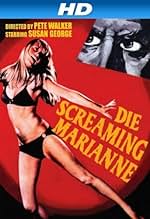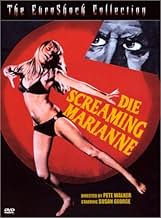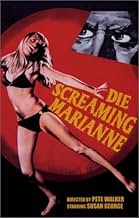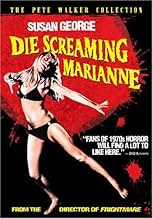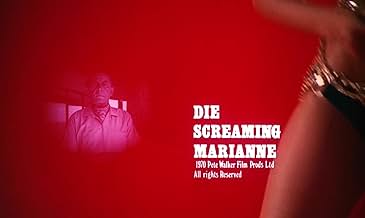Ajouter une intrigue dans votre langueSisters inherit assets from divorced parents. One receives evidence exposing corrupt judge father, the other seeks monetary gain. Escalating battle over desired possessions leads to deadly c... Tout lireSisters inherit assets from divorced parents. One receives evidence exposing corrupt judge father, the other seeks monetary gain. Escalating battle over desired possessions leads to deadly consequences.Sisters inherit assets from divorced parents. One receives evidence exposing corrupt judge father, the other seeks monetary gain. Escalating battle over desired possessions leads to deadly consequences.
- Réalisation
- Scénario
- Casting principal
- British Police Detective - Dark Hair
- (as John Laurimore)
- Man in street
- (non crédité)
Avis à la une
This disjointed relic from British Cinema's Bronze Age features George as a bonne viveuse who is keeping her distance from a dis-functional family which threaten to unravel her hopes of a normal romantic life, and all because she possesses within her mind the secret swiss bank account number which contains her inheritance, which will be entirely her's when she reaches the age of 21. Various losers try to get her to come across with the goods and they certainly take their time with it. And for some odd reason Maryanne tags along with their schemes right up till the last minute even though she knows who she's dealing with. It's kind of confusing.
There is a cheesy song about Maryanne at the end, and the opening credits are rather dated, with Ms. George doing her best go-go dancer routine.
Aside from being an early example of a Walker film, this one is notable for featuring Susan George in a starring role a year before she appeared in Sam Peckinpah's controversial Straw Dogs (1971). In truth, the opening credit sequence which has her gyrating in a bikini in front of a deep red background is very striking indeed, although it is probably in fairness the best bit in the entire film. The main issue with this one is its pretty poor script which meanders about somewhat with a definite lack of focus. The first half of the film which is set in England is the better part with some intrigue and character set-ups but once the action relocates to Portugal things grind to a bit of a halt and it does get a bit boring. It's kind of unfortunate, as the bare bones of the story has got at least some potential but there is something very half-hearted in how things are ultimately played out. Seemingly Walker had some issues with the young cast members during the Portuguese section and this may account for the results on screen being less than impressive. Whatever the case, this is still worth seeing if you have an interest in Walker's movies as it does at least showcase some of his recurring themes such as elderly villains interfering with the lives of the younger generation. But, despite its director and cute leading lady, it has to be admitted that this is not essential stuff by any means. With its cool title and nice cover art it will look good in your film library though and that's not such a terrible thing I guess.
Not just *a* Judge, but 'The Judge' - Leo Genn's character who is continually accorded the definite article by sundry friends and enemies - who are largely interchangeable. This melodrama, with a heavy accent on the corrupt authority figures, bears some resemblance to Pete Walker's later baroque horrors. But the formula isn't developed as of yet - and he had yet to work with the waggish scriptwriter David McGillivray. Walker followed this film with the relatively interesting curio, "The Flesh and Blood Show" - collaborating with the talented veteran Alfred Shaughnessy of "Upstairs, Downstairs" fame - and then his fecund period began with "The House of Whipcord" in 1974.
Susan George and Judy Huxtable are done a great disservice by Walker and scriptwriter Murray Smith here with their reductive portrayal of female characters. Such as shame for George in particular, subject of much brutality in Peckinpah's "Straw Dogs" the following year, but also Huxtable, who was the evocative beauty at the heart of the whimsical "Les Bicylettes de Belsize" two years earlier.
There is always some degree of objectification of women in Walker's films, but what is lacking here is the suspenseful, charged context of his later films. "Frightmare" and "House of Mortal Sin" have something of the Hitchcockian about them: Hitchcock-meets-the Grimm Brothers-meets-British exploitation cinema of the 70s. This is a rather more humdrum affair, with even the exotic locations eliciting no more than a Gallic shrug in this viewer.
Unfortunately, this early attempt by the director to break free from his sexploitation roots sees him struggling to find his feet, the plot meandering all over the place, the pacing dreadfully slow, with very little of the bolder elements that would make his later films so much fun; in fact, if it wasn't for George, who looks absolutely stunning throughout, go-go dancing in a bikini during the opening credits, modelling some very short dresses, relaxing in a bubble bath (curse those bubbles!), cavorting in her underwear, and wearing just a towel while trapped in a sauna (Die Steaming, Marianne?), 'Die Screaming, Marianne' would qualify as a total snoozeathon.
3.5 out of 10, generously rounded up to 4 for IMDb.
Le saviez-vous
- AnecdotesThe nightclub sign, translated from Spanish, reads: "This month's special attraction, from England, Marianne [The Hips] McDonald. See her dance go go every night. Admission 50 pesetas," Spanish money, although credits claim the movie was shot "entirely on location in England and the Algarve, Portugal," and the sailors drive up to a poster for a bullfight in Mallorca, toward the Spanish border with France.
- GaffesThe nightclub sign, translated from Spanish, reads: "This month's special attraction, from England, Marianne [The Hips] McDonald. See her dance go go every night. Admission 50 pesetas," Spanish money, although credits claim the movie was shot "entirely on location in England and the Algarve, Portugal," and the sailors drive up to a poster for a bullfight in Mallorca, toward the Spanish border with France.
- Citations
Nightclub Sign: [translated from Spanish] This month's special attraction, from England, Marianne
["THE HIPS"]
Nightclub Sign: McDonald. See her dance go go every night. Admission 50 pesetas
- Versions alternativesThere have been many discrepancies involving the recent DVD release of this title by Image Entertainment:
- The DVD represents the full-length 99-minute version of the film that has not been seen since the 1970s. There have been many versions of the film with various running times. The original U.S. version ran 84 minutes, omitting 15 minutes of crucial scenes. The DVD is the uncut version and has been digitally remastered.
- The version of the film on the DVD is presented in 1.33:1 full frame. Many people claim the film was shot widescreen. Director Pete Walker shot the film in a 1.33:1 open matte aspect ratio with the intention of matting the film at 1.85:1. As the 1.85:1 matting would have eliminated the excess picture info at the top and bottom of the frame, the film is presented as shot.
- ConnexionsFeatured in Courting Controversy (2005)
Meilleurs choix
- How long is Die Screaming Marianne?Alimenté par Alexa
Détails
- Date de sortie
- Pays d’origine
- Langue
- Aussi connu sous le nom de
- Die Screaming Marianne
- Lieux de tournage
- Brighton Railway Station, Queens Rd., Brighton, Angleterre, Royaume-Uni(actress Susan George is seen walking toward this location after exiting Sloopy's)
- Société de production
- Voir plus de crédits d'entreprise sur IMDbPro
Contribuer à cette page



